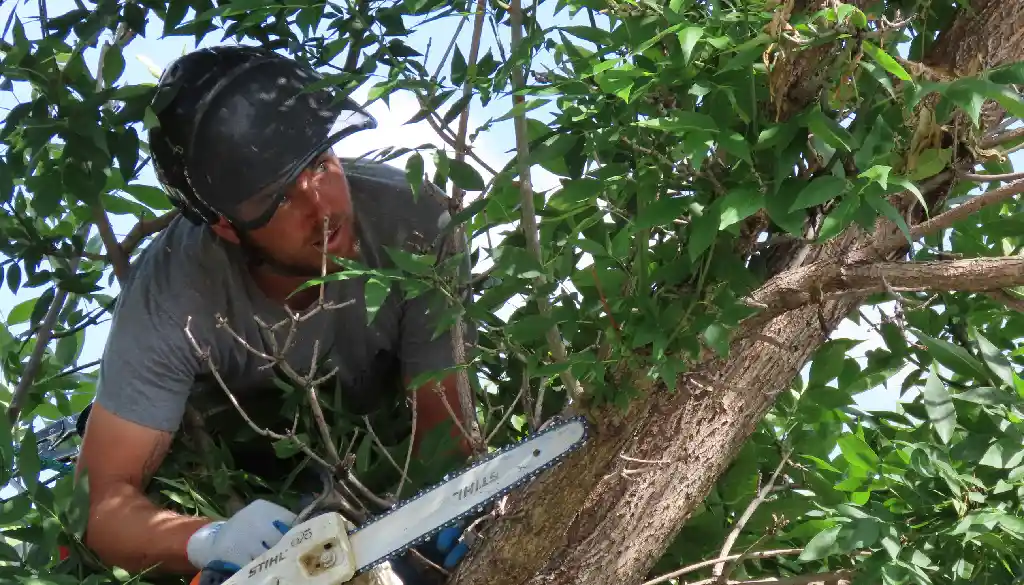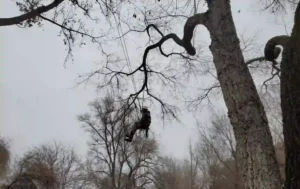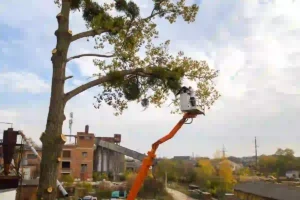Choosing a tree trimming service comes down to five non-negotiable factors: verified insurance coverage, ISA certified arborists on the actual crew, detailed written estimates, verifiable references from similar jobs, and demonstrated species-specific knowledge. Skip any of these and the odds of property damage, tree death, or personal liability increase dramatically.
The right tree service prevents thousands in potential losses. The wrong one creates problems that cost more to fix than the original trimming would have cost if done correctly the first time.
Verify Insurance Before Anything Else
This is the first filter. No current insurance means immediate disqualification.
Every tree service needs two types of insurance coverage. General liability protects your property if they damage it. Workers’ compensation protects you if their employee gets injured on your property. Both policies need to be current. Both need adequate coverage limits.
Ask for certificates of insurance. Actual certificates with policy numbers, coverage amounts, and expiration dates. Not verbal assurances. Not business cards claiming they’re insured. Physical certificates.
Then verify those certificates. Call the insurance company listed on the certificate. Confirm the policy is active. Confirm coverage amounts. This takes five minutes per company. Some contractors show expired certificates. Some show certificates from policies they let lapse. Some show fake certificates entirely.
Tree work is one of the most dangerous occupations. Workers fall from heights. Equipment fails. Branches drop on people. Chainsaws slip. Without workers’ comp, an injured worker can sue you personally. Your homeowners insurance probably won’t cover it because you hired an uninsured contractor.
Without general liability, property damage comes out of your pocket. They drop a branch through your roof? You pay. They damage your neighbor’s fence? You pay. They hit underground utilities? You pay.
Insurance verification is non-negotiable. Companies that push back on verification or delay providing certificates are hiding something. Walk away.
Certified Arborists Matter More Than You Think
ISA certification through the International Society of Arboriculture means actual training in tree biology, disease management, proper pruning techniques, and species-specific care.
Ask if they have ISA certified arborists. Then ask if the certified arborist will be on your job site doing the work. Some companies have one certified arborist in the office who never touches a tree. They send untrained crews to do actual work.
Get the certification number. Verify it on the ISA website. Real certifications show up in their database. Fake ones don’t.
Certified arborists know that different tree species require different approaches. They know oak trees in certain regions can’t be pruned during beetle season. They know pine trees can’t regenerate from bare wood. They know fruit trees need specific timing for optimal production. They know when to prune and when to refuse a job because timing is wrong.

Uncertified workers might know how to operate a chainsaw. That doesn’t mean they know how to prune trees correctly. Bad pruning techniques cause permanent damage. Topped trees develop structural problems that last decades. Wrong cuts invite disease. Removing too much foliage kills trees slowly over one to three years.
The cost difference between certified and uncertified workers is minimal. The damage difference is massive. A dead mature tree costs thousands to remove and decades to replace.
Get Written Estimates with Specific Details
Phone quotes are useless for comparison. Written estimates force companies to commit to specific work scopes and pricing.
Get estimates from at least three companies. Each estimate needs to specify exactly what work gets performed. Which branches get removed or shortened. What trimming method they’ll use (crown thinning, crown raising, crown reduction). How much total foliage they’re removing. What equipment they’ll use.
Good estimates specify cleanup and disposal. Does the price include hauling away all debris? Do they chip branches? Do they cut and leave everything in your yard? Do they rake up small twigs and needles or just remove large pieces?
Good estimates specify timing. When does work start? How long will it take? What happens if weather delays the project?
Good estimates specify what’s excluded. Stump grinding usually costs extra. Treatment of cut surfaces to prevent disease might cost extra. Work on trees not specifically listed costs extra.
Vague estimates like “tree trimming – $600” provide no useful information. Companies providing vague estimates usually do vague work.
Before getting estimates, use treetrimmingcostcalculator.com to understand baseline pricing. Enter your tree height, type, accessibility issues, and zip code. The calculator provides realistic cost ranges based on local market rates and your specific situation.
Small trees under 25 feet typically cost $150-$400. Medium trees (25-50 feet) run $400-$800. Large trees over 50 feet cost $800-$1,500. Extra large trees over 75 feet hit $1,500-$3,000 or more.
When estimates arrive, compare them against this baseline. Someone quoting $200 for a job that should cost $500 is cutting corners somewhere. Someone quoting $1,200 for a job that should cost $600 better have detailed explanations for the premium.
References Tell the Real Story
Ask each company for three references from jobs completed in the last six months. Recent references matter more than old ones. Companies change crews, ownership, and quality over time.
Ask specifically for references with similar trees and situations. If your 60-foot oak sits near power lines, you want references from customers with tall trees near utilities. Not someone whose 15-foot ornamental got trimmed in an open yard.
Call those references. Actually call them. Don’t just collect phone numbers.
Ask specific questions. Did they show up when promised? Did they finish in the quoted timeframe? Were there surprise charges? How did they handle problems or obstacles? Did they damage anything? How thorough was cleanup? Would you hire them again?
Listen for hesitation. If someone pauses before saying yes or qualifies their answer, dig deeper. What made you hesitate? What could they have done better? These questions reveal problems the reference might not volunteer.
Check online reviews across multiple platforms. Google reviews. Better Business Bureau ratings. Yelp if available. Look for patterns.
One or two negative reviews happen to every company. Dozens of complaints about the same issues (surprise charges, property damage, incomplete work, poor cleanup) indicate systemic problems.
Pay attention to how companies respond to negative reviews. Do they get defensive and argue with customers? Do they ignore complaints? Or do they respond professionally and try to resolve issues? Response style predicts how they’ll handle problems on your job.
Species-Specific Knowledge Prevents Disasters
Different tree species have different requirements. Companies should demonstrate specific knowledge about your exact tree type.
Oak trees in regions with oak wilt disease cannot be pruned during beetle season (typically April-June). Pruning during this window exposes trees to disease-carrying beetles. The tree can die within three months of infection.
Pine trees cannot regenerate from bare wood. Cut past the green needle zone and that branch dies. Remove more than one-third of total foliage in a single year and the entire tree often dies within one to three years.
Fruit trees need pruning at specific times for optimal fruit production. Prune too early and lose flower buds. Prune too late and stress the tree.
Palm trees require completely different techniques than traditional trees. Only dead or dying fronds should be removed. Remove too many green fronds and the palm weakens permanently.
Ask potential tree services about their experience with your specific tree species. How many have they worked on? What special considerations apply? When’s the optimal pruning time? What diseases or pests affect this species in your area?
Good answers demonstrate specific knowledge. Bad answers sound generic or copied from websites. If they treat all trees the same, find a different company.
Equipment Quality Signals Professionalism
One of the other things to consider when deciding how to choose a tree trimming service company is their equipment setup. Professional equipment maintained properly signals professional work.
Look at their trucks and equipment during estimates. Well-maintained saws with sharp chains. Climbing gear that looks cared for rather than beat up. Safety equipment like harnesses, hard hats, eye protection. Bucket trucks or rigging equipment in good condition.
Ask about their safety protocols. Do crew members attend regular safety training? How do they handle work near power lines? What emergency procedures exist if someone gets injured?
OSHA has specific safety standards for tree care operations. Professional companies follow them. Amateur operations don’t know they exist.
Watch how they handle your property during the estimate. Do they walk carefully around landscaping? Do they close gates? Do they notice overhead wires and underground utilities? Small details during estimates predict behavior during actual work.
Communication Quality Predicts Problems
How companies communicate during the sales process predicts how they’ll communicate during work.
Do they return calls promptly? Show up on time for estimates? Answer questions clearly without getting defensive? Explain technical terms without being condescending? Listen to your concerns?
If communication feels difficult when they’re trying to win your business, it’ll be worse during actual work. Good communication prevents misunderstandings that create problems later.
Test their communication by asking questions about unclear items in their estimate. See how they respond. Do they clarify willingly? Provide additional helpful information? Or do they get defensive and evasive?
Timing and Availability Signal Demand
Companies booked solid for months usually have good reputations. Extremely long wait times might mean they’re understaffed or overpromised.
Companies available tomorrow might be desperate for work because of poor reputations. Or they might have genuine seasonal availability in slower months.
Winter and early spring typically offer better availability and lower prices. Summer is peak season with higher prices and longer waits. Fall is moderate. This is normal market dynamics.
If someone’s available immediately in July when everyone else is booked six weeks out, ask why. There might be legitimate reasons (cancellation, new company, recent expansion). Or it might signal quality problems that keep customers away.
Emergency services cost more. If a storm damages a tree and immediate work is needed, expect premium rates (50-100% higher than scheduled work). Plan regular maintenance during slower seasons to avoid emergency pricing.
The Selection Process That Works
Start with treetrimmingcostcalculator.com. Get baseline pricing for your specific situation. This prevents accepting unreasonable quotes in either direction.
Contact at least five companies. Request written estimates. Require them to specify:
- Exact work to be performed
- Equipment being used
- Timeline and schedule
- What’s included in price
- What costs extra
- Cleanup and disposal details
Eliminate anyone who can’t provide current insurance certificates. Non-negotiable.
Eliminate anyone without ISA certified arborists on the actual crew doing work.
Eliminate anyone without proper licensing for your area (requirements vary by location).
Check references thoroughly for remaining companies. Call all three references per company. Verify their stories match what the company claimed.
Compare detailed estimates against calculator baseline. Eliminate anyone way above or below without clear explanation.
From remaining options, choose based on:
- Most detailed estimate
- Best references
- Clearest communication
- Strongest species-specific knowledge
- Best safety practices
Don’t choose purely on lowest price. The $300 quote might exclude cleanup that costs another $200 to arrange separately. The $500 quote might include everything plus treatment of cut surfaces to prevent disease.
Cheap work costs more when factoring in property damage, dead trees from poor pruning, or hiring someone else to fix mistakes. Expensive work costs more when paying for overhead rather than quality.
Best value comes from companies meeting all criteria at fair market rates. Fair rates fall within the range the calculator provides for your specific situation.
Red Flags That Demand Walking Away
Some warning signs eliminate companies immediately.
Can’t or won’t provide current insurance certificates. Immediate disqualification.
Pressure tactics. Claims the price is only good today. Says other customers are waiting for your slot. Pushes for deposits before providing detailed written estimates.
Door-to-door solicitation. Especially after storms. Legitimate companies don’t need to knock on doors. Storm-chasing companies do poor work and disappear.
Cash-only payment. Or requests for unusual payment methods. Professional companies accept normal business payments.
No physical business address. Just a cell phone number. No website or online presence. No verifiable business history.
Reluctance to provide references. Or provides only first names without contact information.
Vague estimates without specifics. Won’t commit to exact work scope in writing.
Can’t answer basic questions about tree care. Doesn’t know species-specific requirements. Treats all trees the same.
The Long-Term Relationship Value
Good tree care requires ongoing maintenance. Finding a reliable tree service creates value beyond a single job.
Trees need regular attention. Small maintenance trimming every few years costs less than major corrective work after years of neglect. Regular maintenance keeps trees healthier and prevents hazards.
A tree service that does good work the first time becomes the default choice for future work. No need to repeat the entire selection process. Known quality and fair pricing reduce stress and uncertainty.
Good tree services also provide guidance on tree health issues, pest problems, and when trees need removal rather than trimming. This advice prevents wasting money on work that won’t solve underlying problems.
Taking time to choose correctly the first time creates value that compounds over years. Choosing poorly creates headaches that also compound over years.
Tree care done right protects property values. Mature trees add thousands to property values. Proper care maintains that value. Poor care decreases values and creates hazards that reduce property appeal.
The selection process outlined above takes time. Maybe a few hours total. That time investment prevents problems that take years and thousands of dollars to fix. Worth every minute.



